Article by Sarah Messerschmidt // Apr. 17, 2019
Auckland artist Dane Mitchell has been selected to represent Aotearoa (New Zealand) at the 58th Venice Biennale this summer. His work is concerned with the manifestation of intangible things, giving form to the non-physical in order for his audience to enjoy fleeting encounters with things that cannot be held or touched. The ambitious project, Post hoc, is perhaps his greatest foray into the world of the unseen, constituting an encyclopaedic inventory of vanished, defunct, bygone, destroyed or otherwise nonexistent phenomena, and symbolically revitalising them via their inclusion in his project. This colossal inventory will be transmitted from the pavilion at the Palazzina Canonica to various cell towers installed across Venice, broadcasting for 8 hours a day spanning the 7-month duration of the biennial, and amounting to a stunning average of 10,000 items per day. The inventory will also take a tangible form, printed as a physical list alongside the broadcast, to amass as growing lengths of paper in the empty library of the Palazzina. In preparation, Mitchell has been ceaselessly compiling data on the world’s evanescent detritus – including former nations, discontinued fragrances and extinct birds – to effectively trace “a history of progress” via a retrospective study of “a history of obsolescence”. We caught up with the artist between bouts of research to discuss his project, as well as the implications of charting loss.
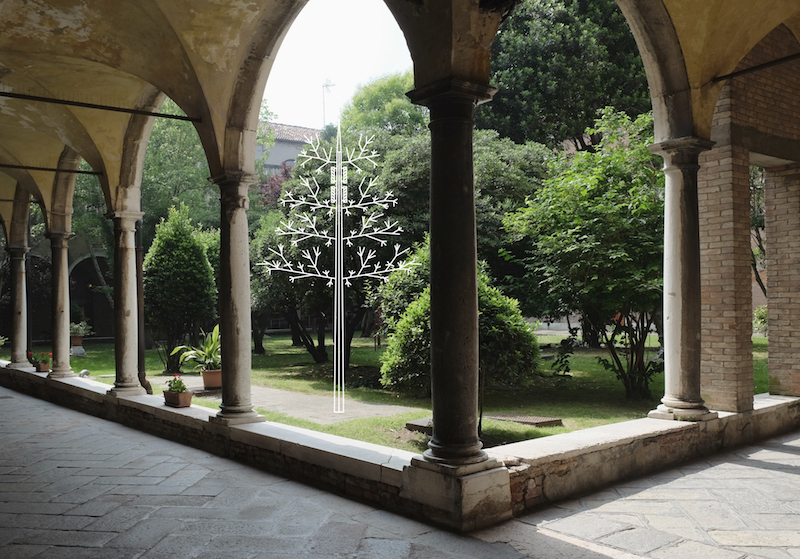
Dane Mitchell: ‘Post hoc’, digital working drawing, 2019 // Image courtesy the artist
Sarah Messerschmidt: Your work in general has a focus on the ephemeral. One might say you have an interest in facilitating experiences with things that are concealed or otherwise materially inaccessible. Can you explain in more detail what draws you to invisible phenomena?
Dane Mitchell: One thing that really started this for me was a consideration of the invisible forces that churn and move around us, that they have a kind of seething presence. The invisible impinges on our lives in all kinds of ways; be it technological, be it spiritual, be it through language. The borders or boundaries of objects are more slippery or blurred than the visible edges would suggest and for me this is an interesting sculptural proposition. I came to this thinking in quite a formal way, considering what kinds of forces extend objects outward from themselves in space to touch us in ways both real – or physical – and poetically charged and meaningful. For instance, when I work with fragrance, I’m thinking about how objects penetrate the body through the nose, the way that these might be holographic forms that take shape in the brain. When we experience smell we are also encountering objects, we are having an experience with a molecular form. I also think the unseen often has a political weight; it has a social dimension or a social property. This project in Venice is deeply embedded in that thinking.
SM: And with Post hoc, do you hope to indicate the influence of the human epoch on the Earth via this inventory of lost phenomena? Will the things now defunct, destroyed, obsolete, vanished, etc., be things mostly relating to human existence?
DM: Yes, or human impact. The notion of an epoch change is certainly something the work rubs up against, though I’m careful not to stage the work as a moral lesson, and I think the title goes some way to suggest that. “Post hoc” translates directly to “after this” and, of course, it’s in Latin, which is actually classified as a dead language because it’s no longer spoken, even though it’s still used. “Post hoc” suggests that we’re somehow living in a period of after-ness, after all these defunct, obsolete, withdrawn phenomena. “Post hoc” is also part of a longer phrase, “post hoc ergo propter hoc”, which is a phrase that suggests “after this” or “because of this”, and yet we should be cautious when assuming causal links between things. We are no doubt obliged to consider possible links between a lot of the material, but the title also attempts to alleviate the responsibility of the work to make moral judgements. It’s really about calling this stuff back up momentarily and allowing the colossal weight of gone-ness to be momentarily figured through language, through a speech-act in the present moment. And not all of the things on the list are necessarily bad; some lists include superseded medical procedures, cured diseases, things we can be glad are no longer.
Certainly, I’m interested in thinking about the Anthropocene as a changing epoch. A lot of the lists also deal with geological time or deep space, they deal with material knowledge (eons and epochs are all listed; in fact, the shortest list includes a list of former super-eons, of which there is one). So yes, I’m certainly interested in our collective responsibility to this material, but I’m also interested in thinking about it as a super-abundant weight that sits below the present moment, and that through this act of speaking something, we call it up momentarily. It’s a type of conjuring, really, like an incantation. It acknowledges how we use language to produce reality.
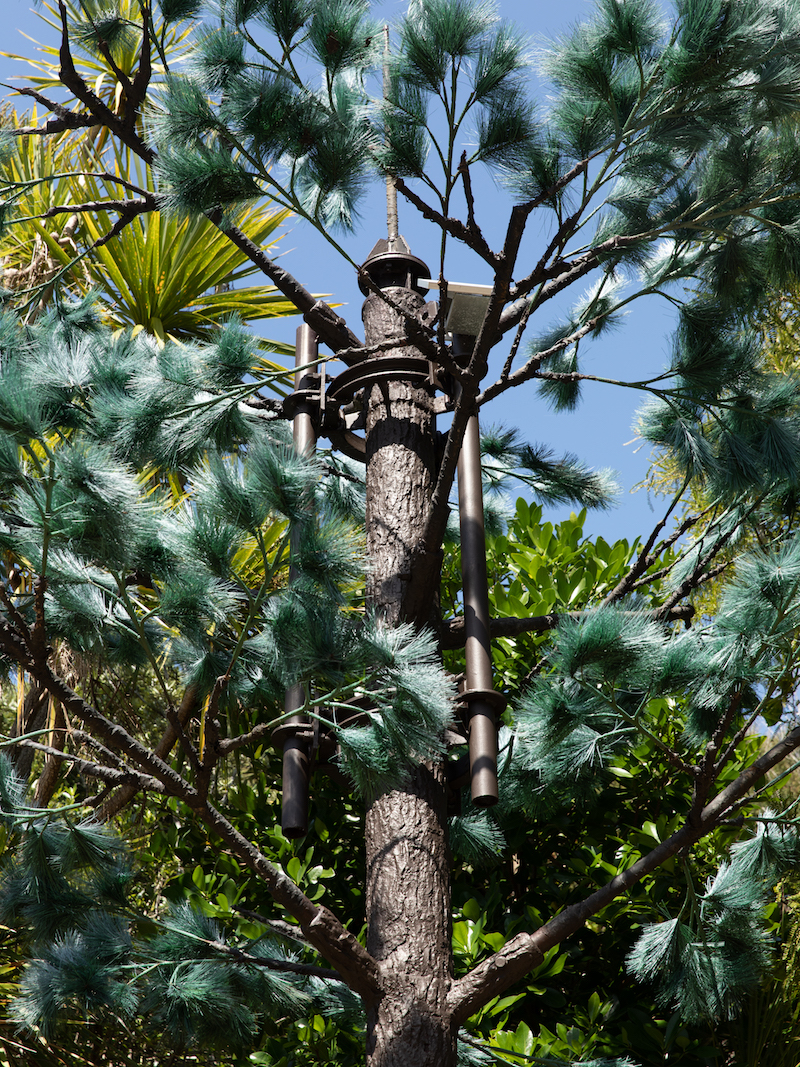
Dane Mitchell: ‘Hiding in Plain Sight’ (detail) Stealth Transmission Tower #1, 2017, Connells Bay Sculpture Park, galvanised steel, mild steel, plastic, FM transmitter, electrical components, electrical cabling and solar panels // Image courtesy the artist and Hopkinson Mossman, New Zealand
SM: In terms of language, I notice some parallels between Post hoc and Stealth Transmission Tower #1, which you made for the Connells Bay Sculpture Park in 2017. Both play with this idea of transmitting information. But, perhaps more notably, for each work you have conspicuously disguised cell towers as trees. To you, what is the significance of broadcasting information in this way, and why must the means to broadcast be camouflaged?
DM: My work thinks about objects as transmitters. Artworks are also transmitters in the sense that they transmit meanings or ideas or images. This led me to think about actual transmission as a form of invisible networked connection. Again, it’s a way to think of extending an object outward beyond itself. We are surrounded by these invisible electro-magnetic networks, on which we are so reliant at this moment in time, and in a way we take for granted this connection, particularly in terms of its hardware. I wanted to think about Post hoc specifically as a kind of contagion across the Venetian landscape, so that the work literally extends outwards from the pavilions to these nodes throughout the city in order to create a thin, horizontal field of activation. Each of these trees has a radial sphere of effect, so the transmissions can be grabbed out of the air by way of a handheld device, or by the ear directly off the trees (the trees transmit in two ways: they have speakers embedded in their trunks, and they are also part of a closed network that can be joined with a handheld device).
In terms of camouflage, you could also ask: “why trees?” and “why pines?” With the Stealth Transmission Tower in Auckland, I was interested in these stealth towers I’d first encountered in LA, which I’d seen as palm trees on the side of the freeway. To me, what was really curious about them is that humans have always had the inclination to mimic nature, but in this case they did a terrible job of it. When you try to conceal something, often the opposite happens: the object becomes more conspicuous. In terms of the Venetian context, I was thinking about the Giardini della Biennale, which is a garden. A garden is a kind of fiction, it’s not strictly nature. Of course, nature grows in that space, but it is nevertheless a fabricated environment. The Giardini in Venice is also interesting for its political level of fabrication. It’s a geo-political map of a certain moment in the 20th century, and New Zealand falls outside of that space. We do not have a pavilion. We’re a kind of absence; not just us, of course there are other countries excluded, too. It led me to think about what a hidden pavilion in the Giardini could look like: it would be a tree, it would mimic nature. Through subterfuge it would enter the garden.
Although there is no tree in the Giardini, I have one very close in the Park of Remembrance in St. Eleanor, which is covered in pines. It was really about the idea that these objects support an invisible network of transmission, and they seek to mimic nature and go unnoticed, but somehow do the opposite, because they’re quite cloying, they’re quite difficult, they’re both antagonistic towards nature while also trying to be it. They are resource heavy: they’re made of steel and plastic, and they are made in China. They are also very deliberately pine. In New Zealand, pine is actually not treated as nature, it’s a technology. It’s an industrial form of nature. It’s a form of capital. In New Zealand we grow pines faster and more aggressively than anywhere else in the world, it’s a huge part of the economy. They’re not natural to the New Zealand landscape, and are actually grown in very controlled environments. So, already, we have a strange relationship to them. Even in their natural state they’re not necessarily “nature”.
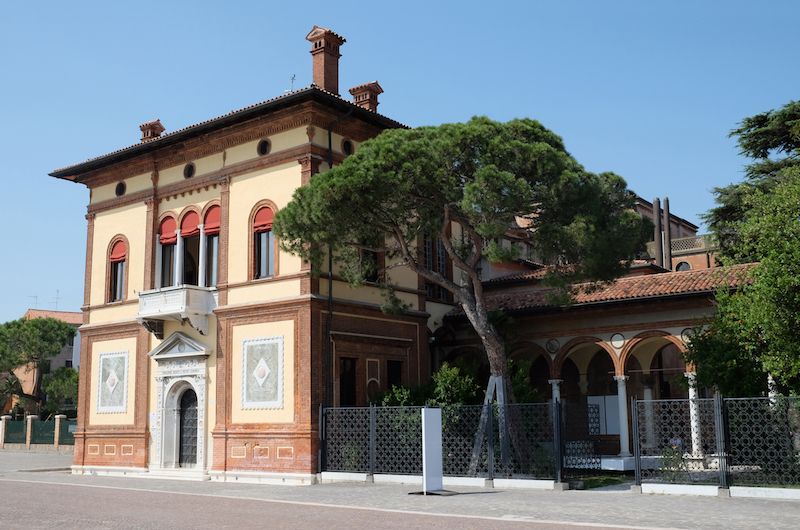
View of the Palazzina Canonica, Venice, New Zealand Pavilion at the Biennale Arte, 2019 // Image courtesy the artist
SM: I’m curious about why you chose to exhibit in the Palazzina Canonica, the former headquarters of the Istituto di Scienze Marine (CNR-ISMAR), as well as to work directly with the Institute to develop research. What was the draw to marine sciences?
DM: The partnership with the Marine Research Institute is twofold: it’s an actual partnership, since they have been directly involved with some of the research for the lists. But there’s also a kind of poetic partnership. The ocean is a site of great loss. It’s a site that is writ large in our imaginations of the unseen and the unknown and the distant and the far-reaching. It’s often seen as a surface, when actually it’s a depth; we know less about some parts of the ocean than we do of deep space. So the ocean features large in our imaginings of the unseen, and I really love the idea that somehow by partnering with the Marine Research Institute, there could be a way for that to play a role in people’s reckoning with the work.
Additionally, the institute has a beautiful connection to the project by virtue of its being a research institute, not to mention a scientific one. Though the work itself is not scientific, in its poetics it squints at science. It looks like an encyclopaedia, but of course it embraces the impossibility of the task at hand, and the fallibility of encyclopaedic thinking, of this Western notion that we can somehow contain the world and hold it aloft in a library. The sites that we’ve engaged across the city are also active players in the work’s conceptual framework: one of the trees is situated at the University of Architecture, which relates to the concept of the trees as part of our built environment; there’s one situated at the hospital, taking into consideration the hospital as a place of birth and death, as well as a place of naming, and a place of the microscopic; there’s another tree in the Park of Remembrance. The work reaches each far corner of the city. It seems like an interesting proposition for the trees to be outside of the Biennale context in places where people are living and working and studying.
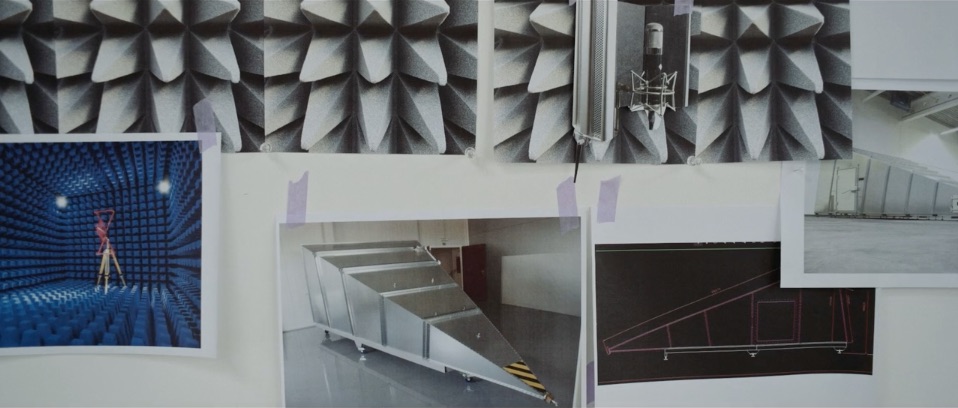
Dane Mitchell: ‘Post hoc’ production still, 2019 // Image courtesy the artist
SM: Concerning the lists themselves, do you find yourself following certain threads, or drawing certain conclusions in terms of what the data might reveal? Does one topic lead to another, or do your personal curiosities lead you to favour certain material?
DM: The whole project is pretty homemade, very “DIY”. There are 260 lists, organised by way of what I call “the list of lists”. I’ve probably completed about 70 percent of them myself. I’ve had 3 researchers working for about a year and a half, and they’ve done some incredible work on some very difficult or troublesome lists. There have been other research bodies that have been very helpful, like the Art Loss Register, which is an organisation that tracks stolen antiquities and artworks in the UK. There have been participating museums in New Zealand and environmental watchdogs; for instance, End Coal have been really helpful with data around abandoned oil platforms and mining. I have had a lot of assistance through existing knowledge, but the lists do follow a meandering, poetic live enquiry that is built by my own authorship.
SM: A very homegrown process…
DM: Right, and it’s nearly killed me. When I started the project, I started with 10 lists, and really, the lists began growing naturally. That was a really exciting part of the process, coming up with new lists. It’s the heart of the work for me. I was definitely drawing conclusions, and some of those lists are deeply sad. Islands, for instance, one of which I come from, feature prominently on the lists, particularly in terms of the extinction of birds, lost environments, collapsed oceanic habitats. I suppose some of the conclusions I’ve drawn are that islands feature prominently on the lists, and they highlight extinction and loss of sentient creatures. The other sort of conclusion is that the works are a product of my own filter bubble. They are the size of my own world through the language I speak, the geographical location I am in and the predominance of the West on the internet. Some of those lists can be seen dually as a list of lost things of one kind, but also a list of who has more prominence [on the internet] and who has less. The US features heavily in these lists because the internet, or the people working to build knowledge in certain fields of data on the internet, combined with my own experience as an English speaker, are such that there are dominant geographic and political entities that feature more diabolically in the project than others.
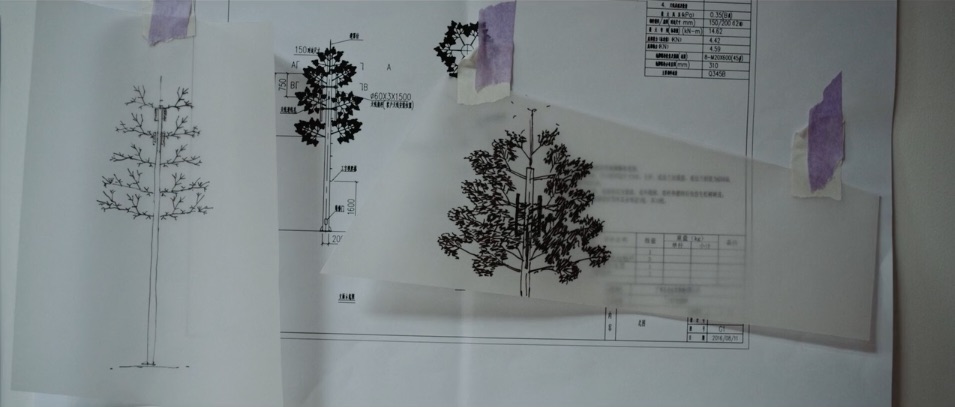
Dane Mitchell: ‘Post hoc’ production still, 2019 // Image courtesy the artist
Exhibition Info
VENICE BIENNALE – NEW ZEALAND PAVILION
Dane Mitchell: ‘Post hoc’
Exhibition: May 11–Nov. 24, 2019
Palazzina Canonica, Riva dei Sette Martiri, 1364, 30122 Venezia VE, click here for map




















